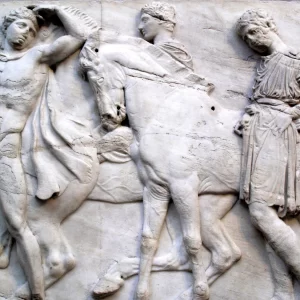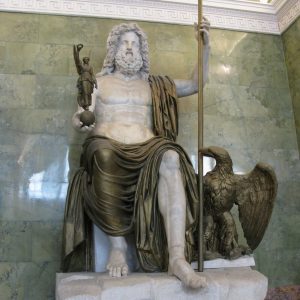Phidias
Showing all 2 results
Phidias, renowned as a multifaceted artist in ancient Greece, flourished between 480–430 BC, leaving an indelible mark as a sculptor, painter, and architect. His illustrious craftsmanship adorned the annals of history, culminating in the creation of the awe-inspiring Statue of Zeus at Olympia, celebrated as one of the Seven Wonders of the Ancient World. Yet, his artistic prowess extended beyond this magnum opus to encompass other monumental works, notably the striking statues of the goddess Athena that graced the Athenian Acropolis.
Among Phidias’ remarkable contributions stands the iconic Athena Parthenos, housed within the Parthenon, an architectural marvel atop the Acropolis in Athens. Additionally, his masterful creation, the Athena Promachos, a colossal bronze statue, stood majestically between the Parthenon and the Propylaea—an imposing gateway heralding the entrance to the sacred precinct of the Acropolis. The craftsmanship evident in these sculptures not only reflected Phidias’ artistic genius but also defined the aesthetic essence of Classical Greek sculptural design.
The lineage of Phidias traced back to Charmides of Athens, anchoring his roots within the cultural and intellectual milieu of the city-state. Accounts from antiquity speculated about Phidias’ mentors, attributing his artistic tutelage to the revered masters Hegias and Ageladas, whose guidance likely shaped his prodigious talent and artistic vision.
Historical narratives intertwine Phidias’ life with that of the influential Greek statesman Pericles, showcasing a friendship that sparked controversy and intrigue. Plutarch delves into their relationship, chronicling a turbulent period where adversaries of Pericles sought to tarnish his reputation through accusations leveled at Phidias. Allegations surfaced, accusing Phidias of pilfering gold designated for the statue of Athena in the Parthenon and purportedly portraying himself and Pericles impiously on the shield of the revered statue. While the veracity of these accounts remains shrouded in debate, Aristophanes, a prominent playwright of the time, referenced an incident involving Phidias that coincided with this tumultuous era.
Phidias’ artistic legacy transcends the temporal confines of ancient Greece, with his craftsmanship earning accolades as a cornerstone of Classical Greek sculpture. Revered by critics and historians alike, Phidias occupies an exalted position among the pantheon of ancient Greek sculptors. His unparalleled contributions to the realm of artistry, characterized by meticulous craftsmanship and an innate understanding of form and proportion, have stood the test of time.
Regarded as a progenitor of Classical Greek sculptural design, Phidias’ oeuvre epitomizes the quintessence of artistic excellence. His sculptures exude a harmonious blend of aesthetic brilliance and technical finesse, serving as a testament to his unparalleled skill and visionary approach to art. Today, the enduring legacy of Phidias resonates as a testament to the heights that artistic expression can attain, inspiring admiration and veneration for his unparalleled contributions to the realm of ancient Greek art and culture.


